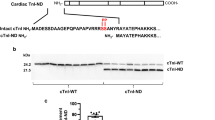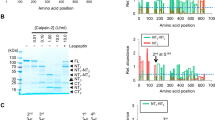Abstract
Calpain-1 is a ubiquitous intracellular Ca2+-activated protease, which has been implicated in the pathogenesis of reversible myocardial depression (i.e. myocardial stunning) that follows ischemia and reperfusion via myofibrillar protein degradation. However, the target proteins of this degradative process in the human myocardium have not yet been identified. In order to compare the levels of Calpain-1 susceptibility within a set of human myofibrillar proteins (titin, α-fodrin, desmin, troponin T (cTnT), troponin I (cTnI) and α-actinin), crude left ventricular tissue homogenates were incubated for 0.5, 15, 30, 60 or 120 min in the presence of Calpain-1 (1 U or 5 U). Differences in the kinetics and extents of protein degradation were subsequently evaluated by using silver-stained SDS-polyacrylamide gels and Western immunoblot analyses. These assays revealed myofibrillar proteins with high (titin and α-fodrin), moderate (desmin and cTnT), or low (cTnI and α-actinin) relative Calpain-1 susceptibilities. The level of phosphorylation of cTnI did not explain its relatively low Calpain-1 susceptibility. Moreover, the molecular mass distributions of the truncated α-fodrin, desmin and cTnI fragments resulting from Ca2+-dependent autoproteolysis exhibited marked similarities with those of their Calpain-1-clipped products. These in vitro results shed light on a number of structural (titin, α-fodrin, desmin and α-actinin) and regulatory (cTnT and cTnI) proteins within the contractile apparatus as potential targets of Calpain-1. Their degradation may contribute to the development of postischemic stunning in the human myocardium. (Mol Cell Biochem 278: 1–8, 2005)
Similar content being viewed by others
References
Gao WD, Atar D, Backx PH, Marban E: Relationship between intracellular calcium and contractile force in stunned myocardium. Direct evidence for decreased myofilament Ca2+ responsiveness and altered diastolic function in intact ventricular muscle. Circ Res 76: 1036–1048, 1995
Matsumura Y, Saeki E, Inoue M, Hori M, Kamada T, Kusuoka H: Inhomogeneous disappearance of myofilament-related cytoskeletal proteins in stunned myocardium of guinea pig. Circ Res 79: 447–454, 1996
Bolli R, Marban E: Molecular and cellular mechanisms of myocardial stunning. Physiol Rev 79: 609–634, 1999
Gao WD, Atar D, Liu Y, Perez NG, Murphy AM, Marban E: Role of troponin I proteolysis in the pathogenesis of stunned myocardium. Circ Res 80: 393–399, 1997
van Eyk JE, Powers F, Law W, Larue C, Hodges RS, Solaro RJ: Breakdown and release of myofilament proteins during ischemia and ischemia/reperfusion in rat hearts: identification of degradation products and effects on the pCa-force relation. Circ Res 82: 261–271, 1998
McDonough JL, Arrell DK, Van Eyk JE: Troponin I degradation and covalent complex formation accompanies myocardial ischemia/reperfusion injury. Circ Res 84: 9–20, 1999
McDonough JL, Labugger R, Pickett W, Tse MY, MacKenzie S, Pang SC, Atar D, Ropchan G, Van Eyk JE: Cardiac troponin I is modified in the myocardium of bypass patients. Circulation 103: 58–64, 2001
Murphy AM, Kögler H, Georgakopoulos D, McDonough JL, Kass DA, van Eyk JE, Marbán E: Transgenic mouse model of stunned myocardium. Science 287: 488–491, 2000
Gao WD, Liu Y, Mellgren R, Marban E: Intrinsic myofilament alterations underlying the decreased contractility of stunned myocardium. A consequence of Ca2+-dependent proteolysis? Circ Res 78: 455–465, 1996
Papp Z, van der Velden J, Stienen GJM: Calpain-I induced alterations in the cytoskeletal structure and impaired mechanical properties of single myocytes of rat heart. Cardiovasc Res 45: 981–993, 2000
Thomas SA, Fallavollita JA, Lee TC, Feng J, Canty JM Jr: Absence of troponin I degradation or altered sarcoplasmic reticulum uptake protein expression after reversible ischemia in swine. Circ Res 85: 446–456, 1999
Lüss H, Meissner A, Rolf N, van Aken H, Bokník P, Kirchhefer U, Knapp J, Läer S, Linck B, Lüss I, Müller FU, Neumann J, Schmitz W: Biochemical mechanism(s) of stunning in conscious dogs. Am J Physiol Heart Circ Physiol 279: 176–184, 2000
Feng J, Schaus BJ, Fallavollita JA, Lee TC, Canty JM Jr: Preload induces troponin I degradation independently of myocardial ischemia. Circulation 103: 2035–2037, 2001
Westfall MV, Solaro RJ: Alterations in myofibrillar function and protein profiles after complete global ischemia in rat hearts. Circ Res 70: 302–313, 1992
di Lisa F, De Tullio R, Salamino F, Barbato R, Melloni E, Siliprandi N, Schiaffino S, Pontremoli S: Specific degradation of troponin T and I by μ-calpain and its modulation by substrate phosphorylation. Biochem J 308: 57–61, 1995
Kim K, Homma Y, Ikeuchi Y, Suzuki A: Cleavage of connectin by calpain and cathepsin D. Biosci Biotechnol Biochem 59: 896–899, 1995
Yoshida K, Inui M, Harada K, Saido TC, Sorimachi Y, Ishihara T, Kawashima S, Sobue K: Reperfusion of rat heart after brief ischemia induces proteolysis of calspectin (nonerythroid spectrin or fodrin) by calpain. Circ Res 77: 603–610, 1995
van der Laarse A: Hypothesis: troponin degradation is one of the factors responsible for deterioration of left ventricular function in heart failure. Cardiovasc Res 56: 8–14, 2002
Giulian GG, Moss RL, Greaser M: Improved methodology for analysis and quantitation of proteins on one-dimensional silver-stained slab gels. Anal Biochem 129: 277–287, 1983
Barta J, Tóth A, Jaquet K, Redlich A, Édes I, Papp Z: Calpain-1-dependent degradation of troponin I mutants found in familial hypertrophic cardiomyopathy. Mol Cell Biochem 251: 83–88, 2003
Neagoe C, Kulke M, del Monte F, Gwathmey JK, de Tombe PP, Hajjar RJ, Linke WA: Titin isoform switch in ischemic human heart disease. Circulation 106: 1333–1341, 2002
Bodor GS, Oakeley AE, Allen PD, Crimmins DL, Ladenson JH, Anderson PA: Troponin I phosphorylation in the normal and failing adult human heart. Circulation 96: 1495–1500, 1997
van der Velden J, Papp Z, Zaremba R, Boontje NM, de Jong JW, Owen VJ, Burton PB, Goldmann P, Jaquet K, Stienen GJ: Increased Ca2+-sensitivity of the contractile apparatus in end-stage human heart failure results from altered phosphorylation of contractile proteins. Cardiovasc Res 57: 37–47, 2003
Goll DE, Dayton WR, Singh I, Robson RM: Studies of the alpha-actinin/actin interaction in the Z-disk by using calpain. J Biol Chem 266: 8501–8510, 1991
Goll DE, Thompson VF, Li H, Wei W, Cong J: The calpain system. Physiol Rev 83: 731–801, 2003
Author information
Authors and Affiliations
Rights and permissions
About this article
Cite this article
Barta, J., Tóth, A., Édes, I. et al. Calpain-1-sensitive myofibrillar proteins of the human myocardium. Mol Cell Biochem 278, 1–8 (2005). https://doi.org/10.1007/s11010-005-1370-7
Received:
Accepted:
Issue Date:
DOI: https://doi.org/10.1007/s11010-005-1370-7




